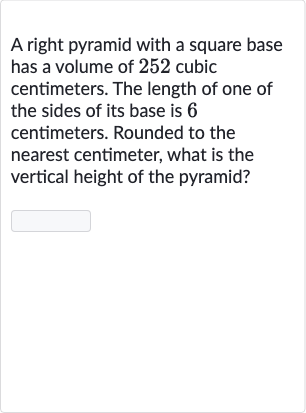Full solution
Q. A right pyramid with a square base has a volume of cubic centimeters. The length of one of the sides of its base is centimeters. Rounded to the nearest centimeter, what is the vertical height of the pyramid?
- Understand formula for volume: Understand the formula for the volume of a pyramid.The volume of a pyramid with a square base is given by the formula .Here, the base area is the area of the square base, which can be calculated as side length squared.
- Plug in given values: Plug in the given values into the volume formula.We know the volume and the side length of the base is .First, calculate the base area: base area = side length side length = \(6 \, \text{cm} \, \text{cm} = \, \text{cm}^\).
- Use volume formula for height: Use the volume formula to find the height.We have , which means .
- Solve for height: Solve for the height.Multiply both sides of the equation by to get rid of the fraction: .This simplifies to .
- Divide to isolate height: Divide both sides by the base area to isolate the height..This simplifies to .
- Round to nearest centimeter: Round the height to the nearest centimeter.The height is already an integer value, so rounding to the nearest centimeter does not change the value: .
More problems from Pythagorean theorem
QuestionGet tutor help
QuestionGet tutor help
QuestionGet tutor help
QuestionGet tutor help
QuestionGet tutor help
QuestionGet tutor help
QuestionGet tutor help
QuestionGet tutor help
QuestionGet tutor help

